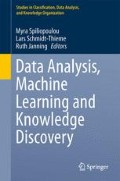Abstract
In modern marketing, knowing the development of different market segments is crucial. However, simply measuring the occurred changes is not sufficient when planning future marketing campaigns. Predictive models are needed to show trends and to forecast abrupt changes such as the elimination of segments, the splitting of a segment, or the like. For predicting changes, continuously collected data are needed. Behavioral data are suitable for spotting trends in customer segments as they can easily be recorded. For detecting changes in a market structure, fuzzy-clustering is used since gradual changes in cluster memberships can implicate future abrupt changes. In this paper, we introduce different measurements for the analysis of gradual changes that comprise the currentness of data and can be used in order to predict abrupt changes.
Access this chapter
Tax calculation will be finalised at checkout
Purchases are for personal use only
References
Bensaid, A. M., Hall, L. O., Bezdek, J. C., Clark, L. P., Silbiger, M. L., Arrington, J. A., et al. (1996). Validity-guided (re)clustering with applications to image segmentation. IEEE Transactions on Fuzzy Systems, 4(2), 112–123.
Böttcher, M., Höppner, F., & Spiliopoulou, M. (2008). On exploiting the power of time in data mining. ACM SIGKDD Explorations Newsletter, 10(2), 3–11.
Crespo, F., & Weber, R. (2005). A methodology for dynamic data mining based on fuzzy clustering. Fuzzy Sets and Systems, 150, 267–284.
Krishnapuram, R., & Keller, J. (1996). The possibilistic C-means algorithm: Insights and recommendations. IEEE Transactions on Fuzzy Systems, 4, 385–393.
Minke, A., Ambrosi, K., & Hahne, F. (2009). Approach for dynamic problems in clustering. In I. N. Athanasiadis, P. A. Mitkas, A. E. Rizzoli, & J. M. Gómez (Eds.), Proceedings of the 4th International Symposium on Information Technologies in Environmental Engineering (ITEE’09) (pp. 373–386). Berlin: Springer.
Author information
Authors and Affiliations
Corresponding author
Editor information
Editors and Affiliations
Rights and permissions
Copyright information
© 2014 Springer International Publishing Switzerland
About this paper
Cite this paper
Minke, A., Ambrosi, K. (2014). Predicting Changes in Market Segments Based on Customer Behavior. In: Spiliopoulou, M., Schmidt-Thieme, L., Janning, R. (eds) Data Analysis, Machine Learning and Knowledge Discovery. Studies in Classification, Data Analysis, and Knowledge Organization. Springer, Cham. https://doi.org/10.1007/978-3-319-01595-8_22
Download citation
DOI: https://doi.org/10.1007/978-3-319-01595-8_22
Published:
Publisher Name: Springer, Cham
Print ISBN: 978-3-319-01594-1
Online ISBN: 978-3-319-01595-8
eBook Packages: Mathematics and StatisticsMathematics and Statistics (R0)

